The new headquarters of the Kostner Group in Vahrn/South Tyrol is in the middle of an industrial estate between the dual carriageway and the motorway. The architecture represents a counterpoint in this situation. A green oasis was created, which more than fulfilled the high ecological and social responsibility demands of the builder. The new office building provides the people who work here with an optimum environment: clean air, tranquility and flexible room structures.
Berlin architects Partner und Partner designed a building with an active climate in a cube shape. The exterior of the five-story building made from solid wood, which can bind 500 tons of CO2, has a weather-resistant façade with controlled charring, which is the revival of an old Japanese wood-preserving technique. The building withstands the extreme external influences with a topping consisting of green plants: This provides cooling, protection from the sun and also filters out fine dust.
The sustainable approach is continued in the interior. Numerous visible surfaces show the importance of the building material wood. The loam rendering and the dry screed also provide a healthy indoor climate. The fact that the opaque door elements were produced from the offcuts of the cross-laminated timber walls is evidence of the conscious use of the raw materials. The flexible layout structure makes easy and reversible adaptation to changes with regard to the way of working, the use of space and the additions to the workforce.
Differentiation from the standard
Roland Giuliani is responsible for a significant part of the development. “As far as I am concerned, it is always about differentiating myself from the standard”, explains the bustling and creatively planning craftsman and furnishing consultant from Brixen, who has been working as an independent consultant since 2009 and established the “Plan Fuenf” (“Plan Five”) company in 2015. Special requirements have always been more of a challenge to him than a deterrent, according to Giuliani.
A special situation such as this arose in the reception area of the Kostner Group’s new office building: The entrance takes you into a two-story open foyer with a central atrium as a meeting area with intersecting staircases. There is a considerable amount of public traffic here, and the employees need to be able to communicate with each other across the floors – all accompanied by an appropriate amount of background noise.
However, there are offices immediately behind the reception desk. The atmosphere is changing all the time. On the one hand, the employees need visual contact with the entrance and the staircases, and want to be ready to communicate with visitors and co-workers. On the other hand, they need to be able to concentrate on their work in a relaxed atmosphere. If necessary, it must therefore be possible to block themselves off from the noise in the atrium and protect themselves from the drafts which blow in via the sliding doors in reception, particularly during the winter.
For Roland Giuliani and the joiners from the Brunner joinery in Freienfeld, it was a case of creating transparent and tightly sealing door elements in accordance with the architect’s specifications and the requirements of the builder which could be flexibly opened and closed without getting in the way in the confined spaces, or taking up additional room. “The intention was always to achieve this using a sliding door”, explains Giuliani. “However, I had my doubts about whether it was actually possible to achieve the acoustic effectiveness that the customer wanted using a sliding hardware.”
Three requirements – one solution
On the way to finding a solution, it was beneficial that Giuliani was not satisfied to adhere to the standard. When he contacted Matthias Tröbinger, the Area Sales Manager for South Tyrol and Austria West at Swiss Hawa Sliding Solutions AG, he discovered that a new sliding hardware was waiting in the wings which significantly reduces the background noise from room to room when the door is closed and also keeps out unwanted odors and drafts thanks to having an optimized, all-round seal.
“The customer is basically very open to trying out new things,” says Tröbinger about Giuliani. “We always keep in contact when we come up with something new or when Roland is confronted with special requirements. When we used the new ‘Hawa Junior 100 B Acoustics’, we clearly benefited from a leap of faith that Roland Giuliani gave us on the basis of our many years of collaboration.” In the end, the planner’s proposal was also well received by the architect’s office and the customer.
Individual design & effortless installation
As a result, two heavy sliding doors weighing about 100 kg emerged as a front-wall solution. The 50 mm thick timber frame construction with paneling made from VSG 6-0.76-6 glass with sound attenuation blends into the design of the glass partition wall system with the RAL 7021 surface, and transfers the black façade design into the interior. It achieves room-to-room sound attenuation of approximately Rw 39 dB.
Roland Giuliani, who took the plunge of using the new hardware without any experience-based knowledge thereof, once again feels like he made the right decision: “I know what Hawa is capable of, and appreciate the company’s reliability. This was yet another occasion which didn’t leave me disappointed.” The “Hawa Junior Acoustics” would also have achieved this, because it makes individual door constructions possible.
Peter Fichter and his co-workers from the Brunner joinery worked out the sliding doors with sound attenuation in detail in accordance with the specifications, carried out the planning and then installed them in the building. “Installation was not a problem”, he reports about his experience. “We were able to manufacture, install and adjust the doors easily using the enclosed instructions.”
Combination of appearance and functionality
The result has also impressed the builder, who involved the entire team in the interactive planning process right from the start. Mike Kostner, one of the builders, sings the praises of the work of Roland Giuliani as “consistently high quality”. He says that the sliding doors in the reception area were predestined for this application. They can be opened in a way that saves space, and the travel routes remain clear.
The doors also have a very visually appealing and eye-catching design. The technology remains hidden. The doors are also generally remarkably sound-attenuating, particularly the two sliding doors, says Kostner. “When the door is closed, you can actually no longer hear what is being said in the adjacent room.”
Worth knowing: “Hawa Acoustics”
With “Hawa Junior Acoustics” and “Hawa Porta Acoustics”, Hawa Sliding Solutions AG has developed two sliding hardware systems with optimized, all-round sealing. They ensure that the noise situation from room to room is noticeably reduced when the door is closed, even by up to 41 decibels with the “Hawa Junior Acoustics”. This effect, which has mostly only believed to be possible using hinged doors until now, predestines the systems for numerous applications in which space-saving also plays a part.
The “Hawa Acoustics” systems move doors weighing up to 100 kilograms easily and quietly with their sliding characteristics and the force deflection of the horizontal seal. “Hawa Junior Acoustics” and “Hawa Porta Acoustics” can both be implemented as a wall-mounted or pocket solution with identical sets, and also in floor-to-ceiling sliding doors. The fabricator can install the doors even after construction is complete, and adjust them later at any time.
The “Hawa Junior 100 B” which was used in Vahrn is designed for passage dimensions of 1.25 m wide and 2.50 m high. It has ball bearing-mounted running gears which provide quiet and comfortable sliding. The door is braked over the last few centimeters when it is closed. The horizontal seals are then released via a ramp. The silicone seal at the bottom can also compensate for unevenness. The vertical seals are attached to the door leaf, and run onto a frame or profile.
Construction sign
- Builder: Kostner GmbH
- Architects: Partner und Partner Architects, Berlin
- Extensions (all office partition walls, mobile acoustic partition wall, two sliding doors): Roland Giuliani, Plan Fuenf, Brixen
- Supporting structure, technical building planning, fire protection, proof of sustainable construction, building supervision: Bergmeister Ingenieure, Vahrn/Italy
- Sound attenuation: TAC – Technical Acoustics, Grevenbroich
- Completion: 2022
- GFS: 1,360 sqm
- Amount of wood used: about 500 m3
Images in high resolution
Please, click on the thumbnail for pictures in high resolution format.
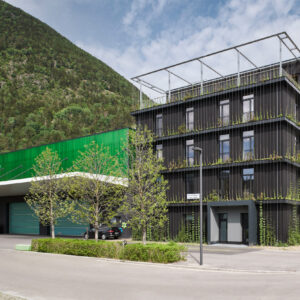 Caption 1: The new headquarters of the Kostner Group in Vahrn/South Tyrol is in the middle of an industrial estate between the dual carriageway and the motorway. The architecture represents a counterpoint in this situation. The green oasis provides the people who work here with an optimum environment: clean air, tranquility and flexible room structures. Photo: Oliver Jaist Photography, Vahrn
Caption 1: The new headquarters of the Kostner Group in Vahrn/South Tyrol is in the middle of an industrial estate between the dual carriageway and the motorway. The architecture represents a counterpoint in this situation. The green oasis provides the people who work here with an optimum environment: clean air, tranquility and flexible room structures. Photo: Oliver Jaist Photography, Vahrn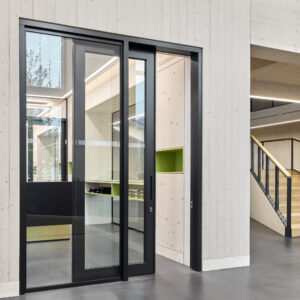 Caption 2: The two sliding doors to the offices on the ground floor make it possible to the employees to screen themselves off from the noise in the atrium and protect themselves from the drafts which blow in via the sliding doors in reception in the winter. Photo: Oliver Jaist Photography, Vahrn
Caption 2: The two sliding doors to the offices on the ground floor make it possible to the employees to screen themselves off from the noise in the atrium and protect themselves from the drafts which blow in via the sliding doors in reception in the winter. Photo: Oliver Jaist Photography, Vahrn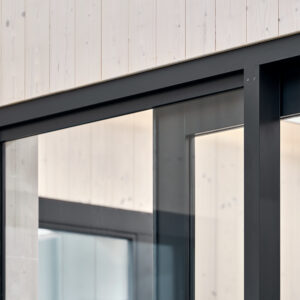 Caption 3: Combination of appearance and functionality in the sliding doors in the reception area: The timber frame construction with its soundproof glass paneling blends into the design of the glass partition wall system and transfers the black façade design into the interior. It achieves room-to-room sound attenuation of approximately Rw 39 dB. The technology remains hidden. Photo: Oliver Jaist Photography, Vahrn
Caption 3: Combination of appearance and functionality in the sliding doors in the reception area: The timber frame construction with its soundproof glass paneling blends into the design of the glass partition wall system and transfers the black façade design into the interior. It achieves room-to-room sound attenuation of approximately Rw 39 dB. The technology remains hidden. Photo: Oliver Jaist Photography, Vahrn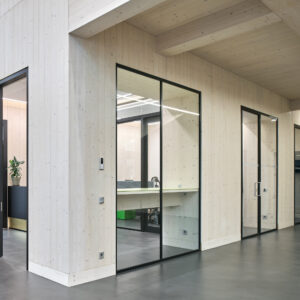 Captions 4 +5: Transparent and tightly sealing door elements were created in accordance with the architect’s specifications and the requirements of the builder which could be flexibly opened and closed without getting in the way in the confined spaces, or taking up additional room. Photo: Oliver Jaist Photography, Vahrn
Captions 4 +5: Transparent and tightly sealing door elements were created in accordance with the architect’s specifications and the requirements of the builder which could be flexibly opened and closed without getting in the way in the confined spaces, or taking up additional room. Photo: Oliver Jaist Photography, Vahrn 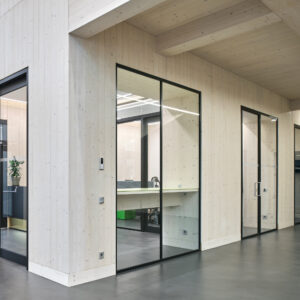 Captions 4 +5: Transparent and tightly sealing door elements were created in accordance with the architect’s specifications and the requirements of the builder which could be flexibly opened and closed without getting in the way in the confined spaces, or taking up additional room. Photo: Oliver Jaist Photography, Vahrn
Captions 4 +5: Transparent and tightly sealing door elements were created in accordance with the architect’s specifications and the requirements of the builder which could be flexibly opened and closed without getting in the way in the confined spaces, or taking up additional room. Photo: Oliver Jaist Photography, Vahrn 



